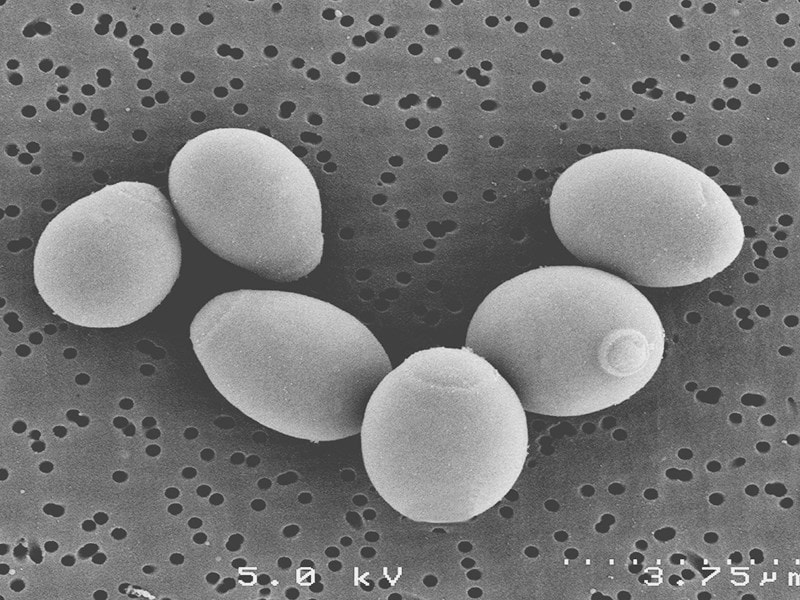Classification of Saccharomyces boulardii
Saccharomyces boulardii is a totally unique live culture as it's the only probiotic yeast. S. boulardii takes its name from Henri Boulard who discovered the yeast in South East Asia in 1923 upon the skins of lychee fruit. This article looks in more depth at the subsequent taxonomic classification of S. boulardii. To learn about the basics of taxonomic classification of probiotics, you may like to read What are Probiotics? on the Probiotics Learning Lab.
Within this article:
- Historically: Saccharomyces boulardii was a species
- Can the taxonomy go further than the term ‘Saccharomyces boulardii’?
- Omission of ‘cerevisiae’ in Saccharomyces boulardii
- Conclusion

Historically: Saccharomyces boulardii was a species
When Saccharomyces boulardii was first discovered it was identified as a yeast, and was therefore classified under the genus Saccharomyces. Within this genus it was given its own species, as its physiological characteristics were thought to be unlike any other yeast.1 It was therefore named:
Saccharomyces [genus] boulardii [species]
Modern day: Saccharomyces boulardii is most likely a strain of the Saccharomyces cerevisiae species
Since early 2000, with advancements in laboratory testing, Saccharomyces boulardii (S. boulardii) has been shown to have certain genomic and structural similarities to the species Saccharomyces cerevisiae. As such it has been moved from being a species on its own, to being a member of the species S. cerevisiae. Quotes from the following papers confirm this:
‘Whether S. boulardii is different from S. cerevisiae was a matter of debate; this debate is now over. Despite certain phenotypic differences, genotypic and proteomic analyses have definitively recognized S. boulardii as a member of the species S. cerevisiae.'2 ...'Taxonomically however, S. boulardii is not accepted as a distinct species. The protein fingerprint obtained after sodium dodecyl sulfate-polyacrylamide gel electrophoresis was identical for all isolates and therefore confirmed the designation of S. boulardii to the species S. cerevisiae.'3...'The results of the present study strongly indicate a close relatedness of S. boulardii to S. cerevisiae and thereby support the recognition of S. boulardii as a member of S. cerevisiae and not as a separate species'.4
Therefore, the classification name and nomenclature was changed, and is now Saccharomyces cerevisiae var boulardii, with the breakdown:
Saccharomyces [genus] cerevisiae [species] var boulardii [strain]
The ‘boulardii’ part of the name has now changed from being the species name, to what must be the strain name. A strain is the lowest possible classification of the characteristics of a microorganism. This part of the name gives us the most detailed picture as to the exact qualities of a microorganism. Provided a high quality supplier is being used, from one capsule of S. boulardii to another, the active ingredient and live microorganisms will all have the same genotypic and phenotypic qualities.
The following studies have conducted specific tests on the genomic and molecular characteristics of S. boulardii, and have concluded that it is a strain of S. cerevisiae:
‘S. boulardii is a strain of S. cerevisiae with some specific genome features including chromosome IX trisomy and different copy numbers of some genes1...The probiotic yeast S. boulardii, classified originally as a separate species, has recently been shown to be a strain of S. cerevisiae, regardless of its strain-specific differences.'1...'Therefore, we conclude that S. boulardii is not a distinct species but is a strain of S. cerevisiae that has lost all intact Ty1/2 elements.'5...'The results of the present study show that these S. boulardii strains are asporogenous strains of the species S. cerevisiae, not representatives of a distinct and separate species, and possess moderate virulence in murine models of systemic infection.'6
Saccharomyces boulardii as a species or subspecies
Whilst one of the papers above states that ‘the debate is now over’, unfortunately there still remains some inconsistency with regards to classification of this microorganism. This could be in part because S. boulardii is a yeast, whereas probiotic suppliers or manufacturers most often handle bacteria, which is arguably more easily classified. It is worth noting that certain manufacturers seem to refer to S. boulardii as a species, and the taxonomical information which follows it (eg. CNCM-I-1079 or Unique28) as the strain; however we would deem this as incorrect, as the evidence above points to ‘boulardii’ being the strain itself. Saccharomyces boulardii is also sometimes referred to as a ‘sub-species’ of S. cerevisiae, for example by some American supplement suppliers7, though some deem this to be incorrect, and misleading to the consumer. We are unable to find any scientific papers which specifically investigate classification and which describe boulardii as a sub-species. Furthermore referring to S. boulardii as a sub-species this would lead one to believe there is further differentiation into strains. As discussed above S. boulardii cannot be further differentiated, and is therefore a strain in itself.

Can the taxonomy go further than the term ‘Saccharomyces boulardii’?
As explored in the previous section, in Saccharomyces boulardii, the term ‘boulardii’ indicates the strain, and therefore the most specific part of the name.
Occasionally additional letters and numbers appear after the strain name, for example S. boulardii MTCC 5375; in this case ‘MTCC 5375’ is the reference number for the microbiology bank in which the strain is deposited. It is not necessary to include the bank reference name on the packaging of this product, as it does not provide the consumer with any additional information on the qualities and characteristics of the product. Similarly, Wren Laboratories Ltd does not include the bank reference number on any other microorganisms in the range, and very few, if any, other companies seem to include the bank reference number on packaging or any consumer-facing materials.
Another type of classification which can follow the strain name is the name given to a particular microorganism by a manufacturer eg. ‘Unique 28’. Again, we deem this additional information insignificant (and unnecessary for the consumer) in terms of identity and characteristics of the microorganism; it simply denotes the laboratory from which this microorganism originates.
It is fairly common to find S. boulardii with different bank reference numbers or manufacturing names on the market. For example,the one used by Wren Laboratories Ltd is S. boulardii CNCM I-1079, supplied by Institut Rosell Lallemand. The first S. boulardii to ever be isolated has the reference number Hansen CBS 5926, and is supplied by Biocodex. Other high quality S. boulardii microorganisms, including the type used by Wren Laboratories Ltd, since then have shown a high level of similarity if not complete similarity to this original isolate, using both laboratory techniques to sequence the genome and clinical trials to indicate mechanism of actions in the body.
Also note that occurrences of Saccharomyces boulardii lyo refer to the lyophilisation (glossary definition on the Probiotics Learning Lab: lyophilisation) of the probiotic and are not referring to a specific strain.
Omission of ‘cerevisiae’ in Saccharomyces boulardii
As aforementioned, the full name for S. boulardii is Saccharomyces cerevisiae var boulardii. At Wren Laboratories Ltd we do not include the species name (cerevisiae) for this product.
S. boulardii is a unique microorganism, by virtue that as a strain it has vastly different properties to other yeasts in the same S. cerevisiae species. For example, baker’s yeast and brewer’s yeast, which are also in the S. cerevisiae species, are known to invoke intolerances in some people.10 Inclusion of the species name in this case could result in consumer confusion – as consumers might understand the Optibac Probiotics S. boulardii to be the same as brewer’s yeast, which is not the case. This is perhaps why, in fact, S. boulardii was previously classified as a separate species – as it has such different properties to the S. cerevisiae species. It may be worth noting that certain experts in the field of microbiology still believe S. boulardii should be classified separately to ‘cerevisiae’.11 Furthermore, for the vast majority of S. boulardii on the market, the species name ‘cerevisiae’ is not listed on packaging and information material.12
Conclusion
Having reviewed scientific papers (both regarding classification in particular, as well as clinical trials examining the effect of S. boulardii) Wren Laboratories Ltd understands S. boulardii to be a strain of yeast, and believes that in the full name Saccharomyces cerevisiae var boulardii, the term ‘var’ is interchangeable with ‘strain’. In an effort to present the most scientifically correct nomenclature, as well as in order to minimise any consumer confusion, Wren Laboratories Ltd does not include ‘cerevisiae’ on packaging or marketing materials, nor the bank reference number CNCM I-1079. Saccharomyces boulardii can be found in Optibac Probiotics Saccharomyces Boulardii.
Learn more about the clinical research behind Saccharomyces boulardii on the Probiotics Database.
If you found this article interesting, you may also like to read the following articles on the Probiotics Learning Lab:
Probiotic yeast found to have positive effects on the human microbiome
Gut Health - All you need to know
References
- Edwards-Ingram L, Gitsham P, Burton N, Warhurst G, Clarke I, Hoyle D, Oliver SG, Stateva L (2007) Genotypic and physiological characterization of Saccharomyces boulardii, the probiotic strain of Saccharomyces cerevisiae. Appl Environ Microbiol 73 8 2458-67
- Herbrecht R, Nivoix Y (2005) Saccharomyces cerevisiae fungemia: an adverse effect of Saccharomyces boulardii probiotic administration. Clin Infect Dis 40 11 1635-7
- Mitterdorfer G, Mayer HK, Kneifel W, Viernstein H (2002) Protein fingerprinting of Saccharomyces isolates with therapeutic relevance using one- and two-dimensional electrophoresis. Proteomics 2 1532-8
- van der Aa KA, Jespersen L (2003) The taxonomic position of Saccharomyces boulardii as evaluated by sequence analysis of the D1/D2 domain of 26S rDNA, the ITS1-5.8S rDNA-ITS2 region and the mitochondrial cytochrome-c oxidase II gene. Syst Appl Microbiol 26 564-71
- Edwards-Ingram L, Gent M, Hoyle D, Hayes A, Stateva L, and Oliver S (2004) Comparative genomic hybridization provides new insights into the molecular taxonomy of the Saccharomyces sensu stricto complex. Genome Res 14 1043-1051
- McCullough M, Clemons K, McCusker J, and Stevens D (1998) Species identification and virulence attributes of Saccharomyces boulardii (nom. inval.). J Clin Microbiol 36 2613-2617
- Now Foods; Jarrow Formulas; BIOCeuticals
- Leading supplements brands which do not include the name of their strains on packaging or marketing materials: Viridian, Higher Nature, Terra nova and New Chapter. Solgar, perhaps the largest supplement company selling in the UK, has very recently starting naming the strains that they use.
- Institut Rosell Lallemand (2017)
- Allergy UK: http://www.allergyuk.org/common-food-intolerances/yeast-intolerance
- McFarland LV (1996) Saccharomyces boulardii is not Saccharomyces cerevisiae. Clin Infect Dis 22 1 200-1. This author is determined that S. boulardii is a completely different species of yeast from baker's, brewer's, or wine yeast. (Note the date 1996 – this has since been overturned)
- Florastor, Ultra-levure, Cytoplan & Metagenics.
Popular Articles
View all General Health articles-
General Health17 Mar 2023


